How To Water Cannabis Plants: A Complete Guide
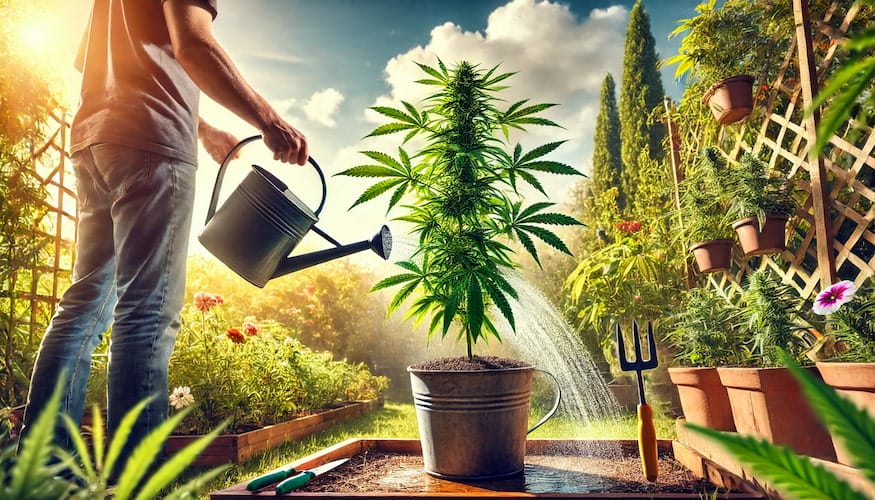
Watering cannabis plants might seem straightforward, but it’s a delicate balance that plays a critical role in the health and productivity of your crop. Whether you’re a novice or an experienced grower, understanding the nuances of watering can make a significant difference in the quality and quantity of your harvest. This guide will walk you through everything you need to know about how to water cannabis plants effectively.
Understanding the Basics
Why Proper Watering is Crucial
Cannabis plants, like all plants, rely on water for essential functions such as nutrient uptake, photosynthesis, and transpiration. Over-watering and under-watering can lead to a variety of problems, including root rot, nutrient deficiencies, and stunted growth. Proper watering ensures your plants remain healthy and vigorous throughout their growth cycle.
Importance of Nutrient Uptake
Water acts as a solvent for nutrients, dissolving them so they can be absorbed by the roots and transported throughout the plant. Without adequate water, cannabis plants cannot take up essential nutrients, leading to deficiencies that can stunt growth and reduce yields.
Role in Photosynthesis
Water is a critical component in the process of photosynthesis, where plants convert light energy into chemical energy. During photosynthesis, water molecules are split into oxygen and hydrogen atoms. The oxygen is released into the atmosphere, while the hydrogen is used to create glucose, the plant’s primary energy source.
Transpiration and Cooling
Transpiration is the process by which water evaporates from the leaves, creating a cooling effect that helps regulate the plant’s temperature. This is particularly important in hot climates, where excessive heat can stress plants and inhibit growth.
The Role of Water in Plant Health
Water maintains cell turgor, which is essential for keeping the plant upright and structurally sound. When cells are fully hydrated, they exert pressure against the cell walls, keeping the plant firm and upright. Conversely, when water is lacking, cells lose turgor pressure, leading to wilting and drooping.
Factors Influencing Watering Needs
Stage of Growth
Seedlings
Seedlings have delicate root systems and require very little water. Over-watering at this stage can lead to damping-off, a fungal disease that causes young plants to collapse and die. It’s best to water seedlings lightly and frequently, ensuring the soil remains moist but not waterlogged.
Vegetative Stage
During vegetative growth, cannabis plants require more water as they develop stems, leaves, and roots. The key is to water thoroughly but infrequently, allowing the soil to dry out slightly between waterings. This encourages the roots to grow deeper and stronger, improving the plant’s overall resilience.
Flowering Stage
Watering needs often increase during flowering, especially as the plants develop dense buds. Proper hydration is crucial to maximize bud size and quality. However, it’s important to avoid over-watering, as excess moisture can lead to mold and mildew in the buds.
Environmental Conditions
Temperature
Higher temperatures increase the rate of water evaporation from the soil and transpiration from the leaves. In hot climates, more frequent watering may be necessary to keep plants hydrated. Conversely, in cooler temperatures, plants may require less water.
Humidity
High humidity reduces the rate of transpiration, meaning plants might need less water. In high humidity environments, it’s crucial to monitor soil moisture closely to avoid over-watering. Conversely, in low humidity conditions, plants lose water more rapidly and require more frequent watering.
Light
The intensity and duration of light exposure affect water needs. Plants under strong grow lights may require more water compared to those in natural light or low-intensity settings. Growers using high-intensity discharge (HID) lights or light-emitting diodes (LEDs) should monitor their plants closely and adjust watering schedules accordingly.
Growing Medium
Soil
Soil retains water well but can also become waterlogged if not properly managed. It’s important to allow the soil to dry out slightly between waterings to prevent root rot. Soil with good drainage properties, such as a mix of peat moss, perlite, and compost, is ideal for cannabis cultivation.
Coco Coir
Coco coir is a popular growing medium for cannabis due to its excellent water retention and aeration properties. However, it can dry out more quickly than soil, requiring more frequent watering. Coco coir also tends to have a neutral pH, making it easier to manage nutrient levels.
Hydroponics
In hydroponic systems, plants receive water continuously. The challenge here is maintaining the right nutrient concentration and oxygenation levels in the water. Regularly checking and adjusting the pH and nutrient levels is crucial for the health of hydroponic cannabis plants.
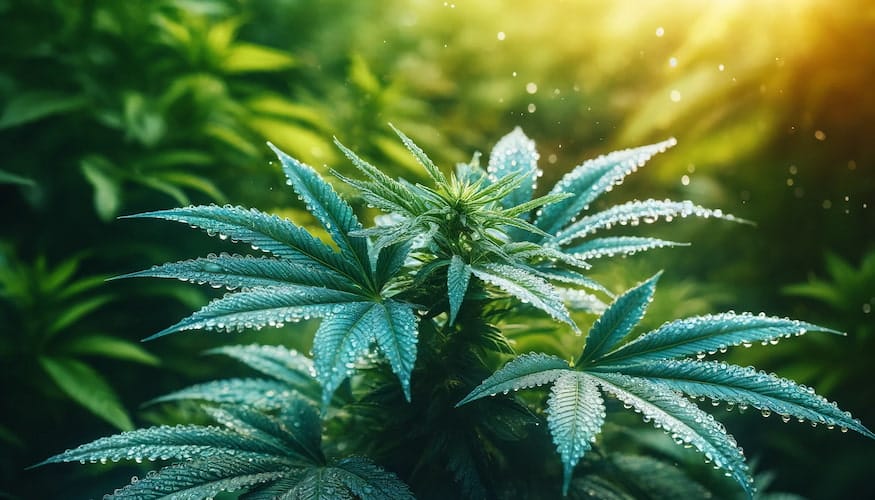
How To Water Cannabis Plants
Tools and Equipment
Watering Can
For small-scale grows, a watering can with a fine rose is ideal. The fine rose helps distribute water evenly and gently, reducing the risk of disturbing the soil or damaging young plants.
Hose with Adjustable Nozzle
For larger operations, a hose with an adjustable nozzle allows for more controlled watering. The nozzle can be adjusted to deliver a gentle spray or a more forceful stream, depending on the needs of the plants.
pH Meter
Ensuring the water’s pH is within the optimal range (6.0-7.0 for soil and 5.5-6.5 for hydroponics) is crucial for nutrient uptake. A digital pH meter provides accurate readings and is a valuable tool for any serious grower.
Moisture Meter
A moisture meter helps determine the soil’s moisture level, preventing over or under-watering. Insert the probe into the soil at various depths to get an accurate reading of the moisture content throughout the root zone.
Water Quality
Tap Water
Tap water often contains chlorine and other chemicals that can be harmful to plants. It’s advisable to let tap water sit out for 24 hours before use or use a water filter to remove impurities. Some growers also use dechlorination tablets or additives to neutralize chlorine.
Distilled Water
Distilled water is free from impurities but lacks essential minerals. It’s best used in combination with nutrient solutions to ensure plants receive all the necessary elements for healthy growth.
Rainwater
Rainwater is generally ideal for plants as it’s natural and free from chemicals. However, it can be inconsistent depending on the weather and local air quality. Collecting and storing rainwater in clean containers can provide a reliable source of high-quality water for your plants.
Watering Techniques
The Finger Test
The simplest way to check if your plants need water is to stick your finger about an inch into the soil. If it feels dry at that depth, it’s time to water. If it still feels moist, wait a day or two before checking again. This method is quick and easy but may not be as accurate as other techniques.
Weight Method
Lift the pots after watering to gauge their weight. When the pots feel significantly lighter, it indicates that the plants need water. This method is particularly useful for indoor growers using containers, as it clearly indicates when the soil is drying out.
Moisture Meter
A moisture meter provides a more precise measurement of the soil’s moisture content. Insert the probe into the soil at various depths to ensure consistent moisture levels throughout the root zone. This tool is especially useful for larger grows where manual checks might be impractical.
Watering Frequency
There’s no one-size-fits-all answer to how often you should water cannabis plants. However, a general guideline is:
Seedlings
Water lightly every two to three days. Seedlings have delicate roots that can be easily damaged by over-watering. It’s best to keep the soil moist but not waterlogged, ensuring a steady supply of water without drowning the young plants.
Vegetative Stage
Water thoroughly every two to four days, depending on the environmental conditions and soil moisture. During the vegetative stage, plants are actively growing and require a consistent supply of water to support their development. Allow the soil to dry out slightly between waterings to promote healthy root growth.
Flowering Stage
Water every two to three days, ensuring the soil dries out slightly between waterings. During flowering, plants use more water as they develop buds. However, it’s important to avoid over-watering, as excess moisture can lead to mold and mildew in the buds.
Watering Amount
When watering, aim to saturate the soil completely but avoid waterlogging. Water should start to drain from the bottom of the pot, indicating that the entire root zone has been moistened. This helps prevent salt build-up in the soil and ensures the roots receive adequate oxygen.
Common Watering Mistakes
Overwatering
Overwatering is one of the most common mistakes made by cannabis growers. Symptoms of overwatering include yellowing leaves, drooping, and root rot. To avoid overwatering, always allow the soil to dry out slightly between waterings.
Symptoms of Overwatering
- Yellowing Leaves: Often an indication of nutrient lockout caused by waterlogged roots.
- Drooping Leaves: While drooping can be a sign of both over and underwatering, overwatered plants will have soft, limp leaves.
- Mold or Mildew: Excess moisture can lead to mold and mildew growth, particularly in high-humidity environments.
Preventing Overwatering
- Use well-draining soil and containers with adequate drainage holes.
- Allow the top inch of soil to dry out before watering again.
- Monitor the weight of the pots to gauge moisture levels.
Underwatering
Underwatering can lead to nutrient deficiencies and stunted growth. Signs of underwatering include wilting leaves and dry, brittle soil. To prevent underwatering, ensure you’re providing enough water based on the plant’s stage of growth and environmental conditions.
Symptoms of Underwatering
- Wilting Leaves: Leaves will appear droopy and wilted when the plant lacks sufficient water.
- Dry Soil: Soil that feels dry and pulls away from the edges of the pot is a sign of underwatering.
- Slow Growth: Underwatered plants often grow more slowly and produce smaller yields.
Preventing Underwatering
- Water consistently and thoroughly, ensuring the soil is saturated.
- Check soil moisture levels regularly using the finger test, weight method, or a moisture meter.
- Increase watering frequency during hot, dry weather.
Incorrect pH Levels
Watering with water that has the incorrect pH can lock out essential nutrients, leading to deficiencies and poor plant health. Regularly check and adjust the pH of your water to ensure it’s within the optimal range for cannabis plants.
Adjusting pH Levels
- Use pH up or pH down solutions to adjust the pH of your water.
- Test the pH regularly using a digital pH meter or pH test strips.
- Aim for a pH of 6.0-7.0 for soil and 5.5-6.5 for hydroponics.
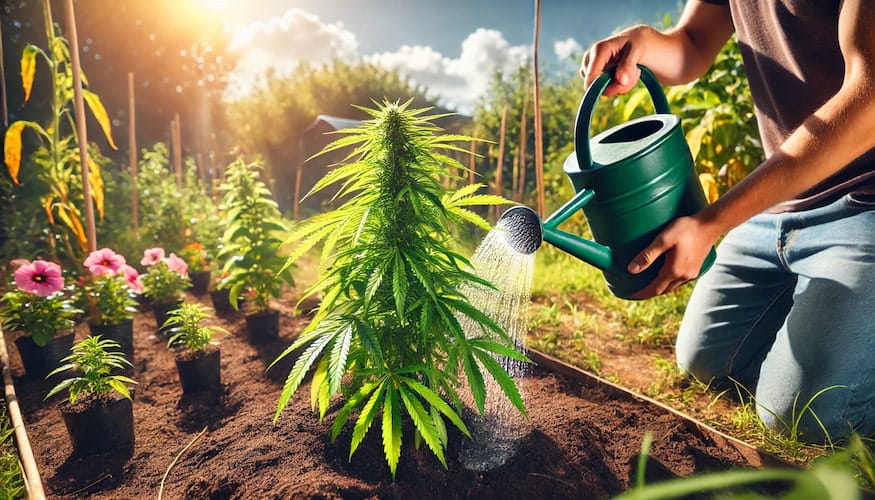
Advanced Watering Techniques
Drip Irrigation Systems
Drip irrigation systems provide a controlled and efficient way to water cannabis plants. These systems deliver water directly to the root zone, reducing evaporation and ensuring consistent moisture levels. Drip irrigation is especially beneficial for large-scale grows and outdoor operations.
Benefits of Drip Irrigation
- Water Efficiency: Reduces water waste by delivering water directly to the roots.
- Consistent Moisture Levels: Ensures plants receive a steady supply of water.
- Reduced Labor: Automates the watering process, saving time and effort.
Setting Up a Drip Irrigation System
- Install a mainline to distribute water to each plant.
- Use emitters or drip lines to deliver water directly to the root zone.
- Set up a timer to automate watering schedules.
Deep Water Culture (DWC)
In DWC systems, plant roots are suspended in a nutrient-rich oxygenated water solution. This hydroponic method allows for rapid growth and can significantly increase yields. However, it requires careful monitoring of water quality and oxygen levels.
Benefits of DWC
- Faster Growth: Plants can grow more quickly in a well-maintained DWC system.
- Increased Yields: DWC can produce larger, healthier plants with higher yields.
- Fewer Pest Issues: Growing in water reduces the risk of soil-borne pests.
Setting Up a DWC System
- Use a reservoir to hold the nutrient solution.
- Suspend plant roots in the solution using net pots or mesh baskets.
- Use an air pump and air stones to oxygenate the water.
Automated Watering Systems
Automated watering systems use timers and sensors to control when and how much water is delivered to your plants. These systems can be particularly useful for busy growers or those with large-scale operations. Automation ensures consistent watering and reduces the risk of human error.
Benefits of Automated Watering
- Consistency: Ensures plants receive water at the same time and amount each day.
- Convenience: Reduces the need for manual watering.
- Precision: Sensors can monitor soil moisture levels and adjust watering schedules accordingly.
Setting Up an Automated Watering System
- Install a timer to control watering schedules.
- Use soil moisture sensors to monitor moisture levels.
- Connect the system to your existing irrigation setup.
Troubleshooting Watering Issues
Signs of Overwatering
- Yellowing Leaves: Often an indication of nutrient lockout caused by waterlogged roots.
- Drooping Leaves: While drooping can be a sign of both over and under-watering, overwatered plants will have soft, limp leaves.
- Mold or Mildew: Excess moisture can lead to mold and mildew growth, particularly in high-humidity environments.
Corrective Actions for Overwatering
- Allow the soil to dry out completely before watering again.
- Ensure pots have adequate drainage.
- Use a lighter, more aerated growing medium.
Signs of Underwatering
- Wilting Leaves: Leaves will appear droopy and wilted when the plant lacks sufficient water.
- Dry Soil: Soil that feels dry and pulls away from the edges of the pot is a sign of underwatering.
- Slow Growth: Underwatered plants often grow more slowly and produce smaller yields.
Corrective Actions for Underwatering
- Increase the frequency and amount of water given to the plants.
- Ensure that the water reaches the entire root zone and not just the surface.
- Consider using mulch to help retain soil moisture.
Incorrect pH Levels
Watering with water that has the incorrect pH can lock out essential nutrients, leading to deficiencies and poor plant health. Regularly check and adjust the pH of your water to ensure it’s within the optimal range for cannabis plants.
Corrective Actions for Incorrect pH Levels
- Use pH up or pH down solutions to adjust the pH of your water.
- Test the pH regularly using a digital pH meter or pH test strips.
- Aim for a pH of 6.0-7.0 for soil and 5.5-6.5 for hydroponics.
Additional Tips for Watering Cannabis Plants
- Avoid Watering at Night: Watering during the day allows the soil to dry out more quickly, reducing the risk of mold and mildew.
- Use Mulch: Mulching around the base of your plants helps retain soil moisture and regulate soil temperature.
- Monitor Plant Health: Regularly check your plants for signs of over or under-watering and adjust your watering schedule accordingly.
- Adjust Watering Based on Plant Size: Larger plants with more extensive root systems will require more water than smaller plants.
- Be Consistent: Establishing a regular watering routine helps ensure your plants receive consistent moisture, promoting healthy growth.
By following these guidelines and paying close attention to your plants’ needs, you can master the art of watering cannabis and enjoy a successful growing season.
How To Water Cannabis Plants: Conclusion
Watering cannabis plants properly is both an art and a science. By understanding the specific needs of your plants at different stages of growth and under varying environmental conditions, you can ensure they receive the right amount of water to thrive. Avoid common mistakes like over and under-watering, monitor pH levels, and consider advanced techniques like drip irrigation or automated systems for optimal results. With careful attention to watering, you’ll be well on your way to a healthy, bountiful cannabis harvest.
Now that you know how to water cannabis plants, get your garden started by shopping the collection of regular, feminized, and autoflower cannabis seeds at Seeds Here Now.
Suggested Articles
;)
;)
;)




 21 Dec 2025
21 Dec 2025  9 min read
9 min read
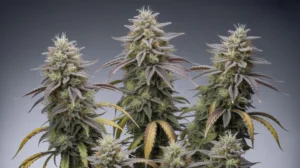
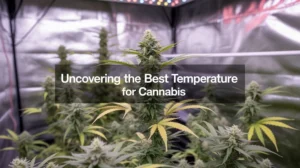
 July 17, 2024
July 17, 2024 


RESPONSES (0)
No responses yet. Be the first to respond!